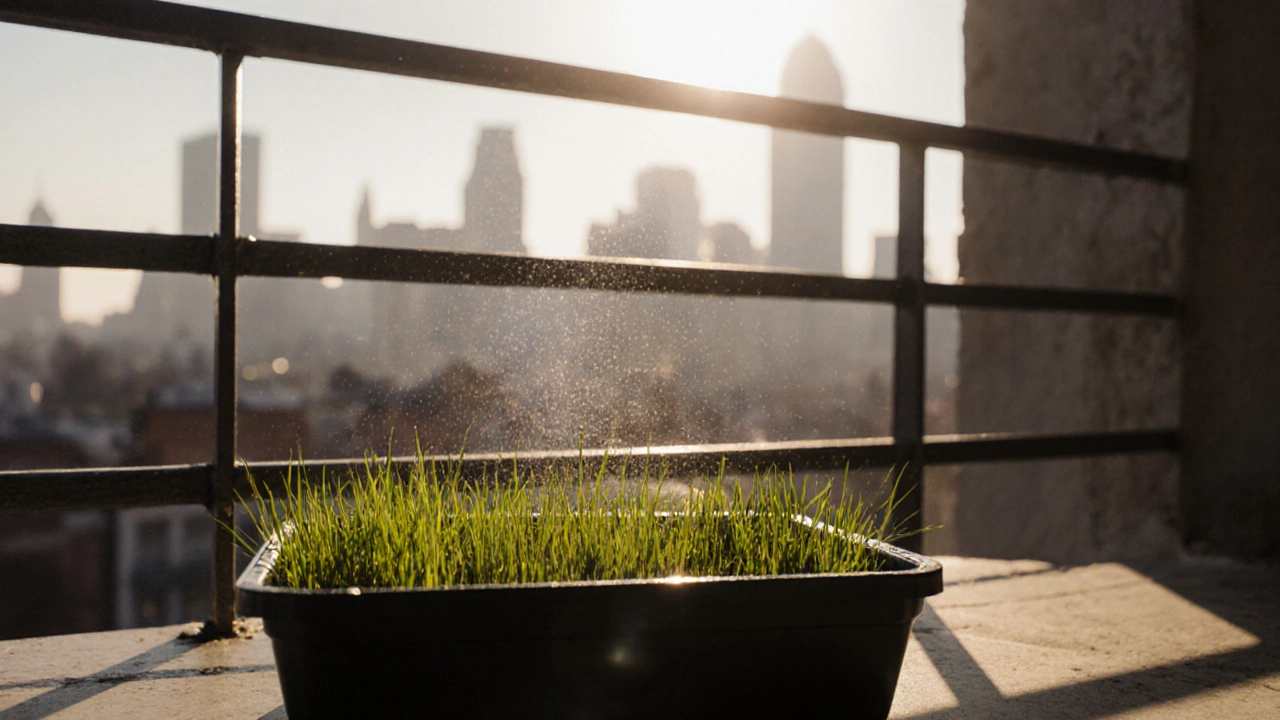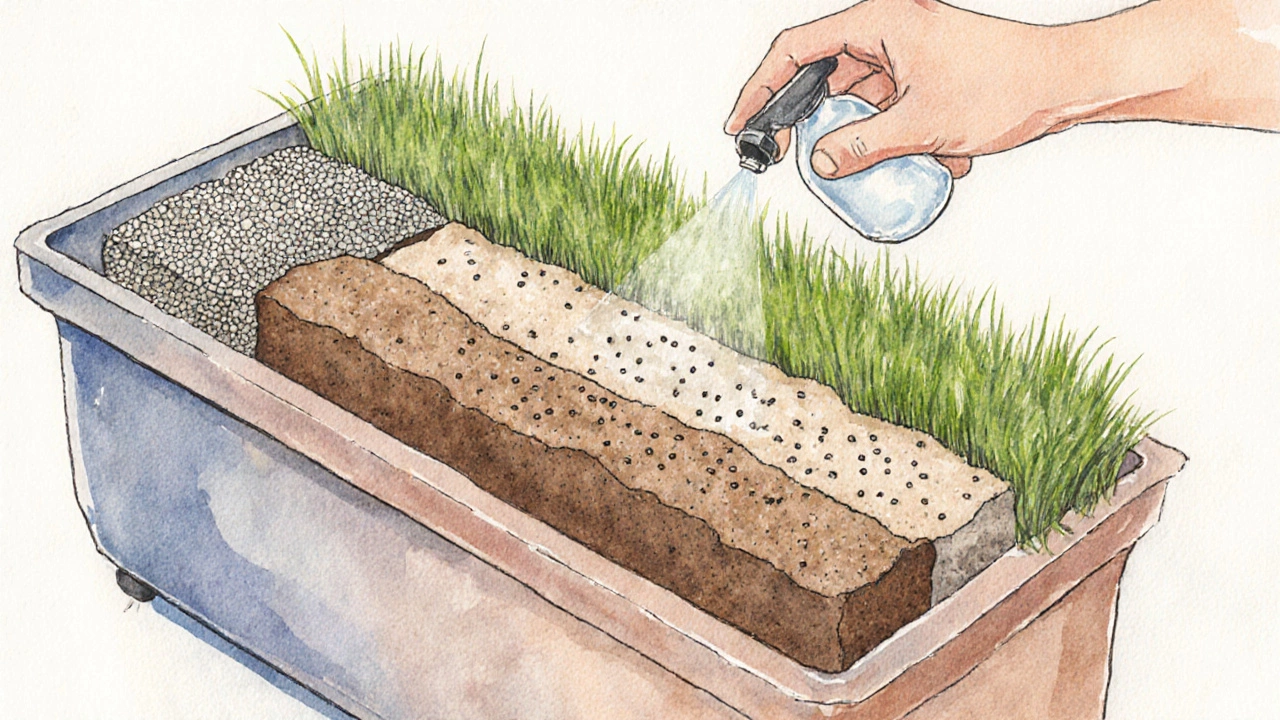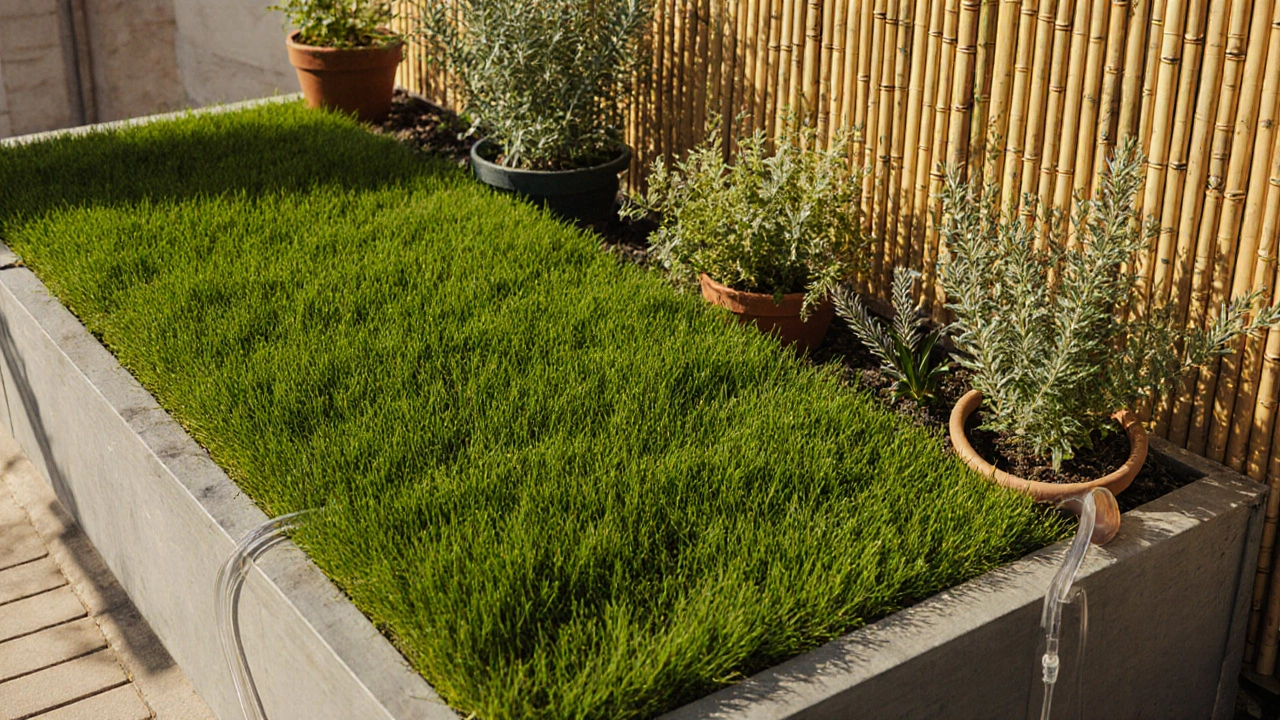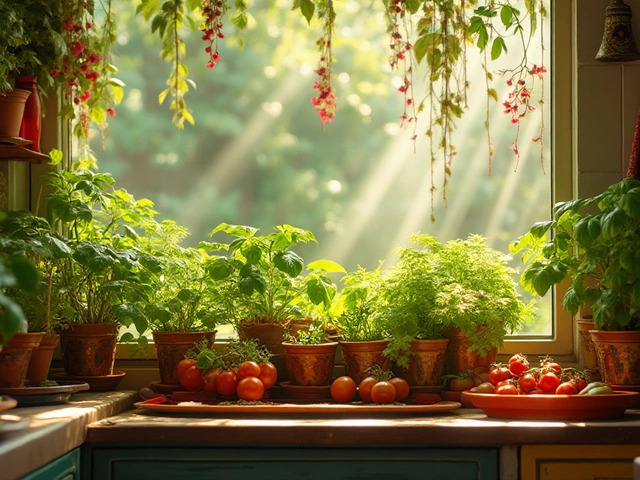How to Grow Grass on a Balcony: Step-by-Step Guide

How to Grow Grass on a Balcony: Step-by-Step Guide
Balcony Grass Selection Guide
Select Your Balcony Conditions
Answer the following questions to find the best grass for your balcony.
Recommended Grass Type
Ever looked out at a city skyline and wondered if you could turn your balcony into a tiny lawn? You’re not alone. Growing grass on a balcony is more doable than most people think, but it takes the right mix of plant choice, containers, soil, and care. In this guide we’ll walk through every decision you’ll face, from picking the perfect grass species to keeping it green through wind and sun. By the end you’ll have a clear plan to roll out a green carpet on your balcony, even if you’ve never tended a lawn before.
Choosing the Right Grass for a Balcony
Not all grasses are created equal, especially when space is limited. Below is a quick rundown of the most balcony‑friendly varieties:
- Fescue is a cool‑season grass that tolerates shade and low foot traffic. It stays fine‑textured and doesn’t grow aggressively, making it ideal for shallow containers.
- Bermuda is a warm‑season grass known for its drought tolerance and rapid spreading habit. Choose dwarf cultivars to keep the mat thin and manageable.
- Kentucky Bluegrass is a cool‑season grass prized for its deep green color and soft feel. It needs more sunlight and regular watering but gives a classic lawn look.
- Zoysia is a warm‑season grass that forms a dense mat and tolerates foot traffic. It’s slower to establish but stays neat for years.
When picking a type, ask yourself three questions: Does my balcony get full sun, partial shade, or deep shade? How much wind does it face? And how often can I water?
Container and Soil Basics
The container is the backbone of your balcony lawn. A few rules of thumb will help you avoid common pitfalls:
- Size matters. Aim for a depth of at least 6‑8 inches (15‑20cm). Shallow trays cause roots to dry out fast; deeper pots hold moisture better.
- Material counts. Plastic retains water, while terracotta is porous and cools the soil. For sunny balconies, a lightweight plastic or fabric grow‑bag works best.
- Drainage is non‑negotiable. Drill holes at the bottom and line with a layer of gravel (small stones that improve drainage) before adding soil.
Speaking of soil, regular garden soil is too heavy for containers. Instead, blend a high‑quality potting mix (a lightweight blend of peat, perlite, and compost) with a handful of organic compost (decomposed plant material that adds nutrients). A 70/30 mix (potting mix/compost) gives good water retention while staying airy enough for root growth.
Watering and Irrigation Tips
Grass loves consistent moisture, but overwatering can drown roots. Here’s a practical watering schedule:
- First two weeks: water daily with a fine mist to keep the top inch of soil moist.
- Weeks 3‑6: reduce to every 2‑3 days, aiming for about 1cm of water per session.
- Beyond 6 weeks: water when the soil feels dry to the touch about 2‑3cm deep.
For a hands‑free approach, install a drip irrigation (a low‑flow system that delivers water directly to the soil) with a timer. A 1‑meter drip line wrapped around the container’s perimeter supplies a steady trickle that mimics natural rainfall.

Sunlight, Wind, and Temperature
Balcony micro‑climates can be harsh. Most grasses need at least 4‑6 hours of direct sun. If you’re in a shady spot, stick with shade‑tolerant varieties like Fine Fescue. For windy balconies, create a windbreak using bamboo fencing, lattice, or a row of taller potted plants in front of the grass container. This reduces drying and physical stress.
Temperature swings are another factor. In hot summers, aim for a mulch layer of shredded bark (about ½ inch) to keep the soil cool. In winter, choose a hardy grass type (e.g., Fescue) and consider moving the container to a sheltered corner or wrapping it with horticultural fleece.
Setting Up and Maintaining Your Balcony Lawn
Now that you have all the pieces, follow these steps to get your lawn thriving:
- Place the container on a sturdy balcony rail or a flat, level surface.
- Add a 2‑inch layer of coarse sand (helps improve drainage and prevents soil compaction) at the bottom, then the gravel layer.
- Fill with the potting‑mix‑and‑compost blend, leaving 1‑2 inches from the rim.
- Spread the grass seed evenly (about 1kg per 10m²) and lightly rake the soil to ensure good seed‑to‑soil contact.
- Cover the seed with a thin layer of straw or a biodegradable seed‑mat to retain moisture.
- Water gently using a spray bottle until the soil is uniformly moist.
- Keep the container in its final spot and monitor daily for the first two weeks.
- Once the grass is 2‑3cm tall, trim with small scissors to encourage a dense mat.
Monthly maintenance includes: checking drainage holes for clogs, trimming any stray blades, and adding a thin spread of slow‑release fertilizer (provides nutrients over several weeks) during the growing season.
Common Mistakes to Avoid
Even seasoned balcony gardeners slip up sometimes. Here are the top errors and how to fix them:
- Over‑watering. If the soil stays soggy for more than 24 hours, roots will rot. Switch to a timer‑controlled drip system.
- Choosing the wrong grass. A sun‑loving Bermuda will struggle in shade. Use the decision matrix below to match species to light levels.
- Neglecting wind protection. Strong gusts dry the soil and tear blades. Add a simple windbreak as mentioned earlier.
- Ignoring soil compaction. Heavy soil shrinks pore space, choking roots. Loosen the top 2 inches with a small fork every few weeks.

Grass Species Comparison
| Grass | Sun Requirement | Water Needs | Maintenance Level | Typical Height |
|---|---|---|---|---|
| Fine Fescue | Partial to full shade | Medium | Low | 2‑4cm |
| Dwarf Bermuda | Full sun | Low‑medium | Medium | 3‑5cm |
| Kentucky Bluegrass | Full sun | High | Medium‑high | 4‑6cm |
| Zoysia | Full sun to light shade | Low | Low‑medium | 3‑5cm |
Key Takeaways
- Pick a grass species that matches your balcony’s light and wind conditions.
- Use a container at least 6‑8inches deep with proper drainage and a light potting‑mix‑plus‑compost blend.
- Water consistently; a drip‑irrigation timer makes the job painless.
- Protect the lawn from wind and extreme heat with windbreaks and a thin mulch layer.
- Regular trimming, fertilizing, and checking drainage keep the balcony lawn healthy year‑round.
Frequently Asked Questions
Can I grow grass on a balcony that gets only morning shade?
Yes. Fine‑leaf Fescue or a dwarf Bermuda that tolerates light shade will thrive with 4‑5 hours of direct sun in the morning. Just keep the soil consistently moist and avoid over‑watering.
How often should I fertilize my balcony grass?
Apply a slow‑release, balanced fertilizer (10‑10‑10) once in early spring and again in midsummer. If you notice yellowing, a light top‑dress with compost will boost nutrients without burning the blades.
Can I use regular garden soil instead of potting mix?
Avoid heavy garden soil; it compacts quickly in containers and retains too much water, leading to root rot. A blend of potting mix and organic compost (70/30) stays light and drains well.
What’s the best way to protect my balcony grass from wind?
Create a simple windbreak using a bamboo screen, lattice panel, or a row of taller potted herbs (like rosemary or sage) placed upwind of the lawn. This reduces drying and helps the soil stay moist.
Can I grow a mixed‑species lawn on my balcony?
Mixing compatible grasses (e.g., Fine Fescue with Dwarf Bermuda) can create a more resilient mat, but keep the blend simple-no more than two varieties-so you can manage light and water needs without confusion.
About
Gardener Support India is your go-to online destination for expert advice on gardening and horticultural services in India. Whether you're a beginner or an experienced gardener, our platform offers extensive resources, tips, and support tailored to Indian climates and plant species. Explore a wide range of guides on plant care, sustainable gardening practices, and innovative gardening solutions. Connect with local experts to enhance your gardening experience and maintain a flourishing garden. Our dedicated services aim to empower Indian gardeners with the knowledge and tools needed for a successful gardening journey.
Latest Posts


Why Is Drip Irrigation So Expensive? Breaking Down the Real Costs and Saving Tips
By Alden Thorne Jul 22, 2025

Calculating Soil Needed for a 4x8 Raised Garden Bed
By Alden Thorne Jan 29, 2025

Grow Fresh Vegetables in Your Kitchen: A Complete Guide
By Alden Thorne Jan 1, 2025

Write a comment